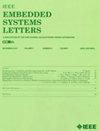An Explainable and Formal Framework for Hypertension Monitoring Using ECG and PPG
IF 1.7
4区 计算机科学
Q3 COMPUTER SCIENCE, HARDWARE & ARCHITECTURE
引用次数: 0
Abstract
An alarming increase in hypertension is a hazard to global health that poses severe implications for the body’s vital organs. To prevent serious repercussions, hypertension should be monitored continuously for early detection. It is well known that physiological signals, such as the photoplethysmogram (PPG) and electrocardiogram (ECG), carry essential information about the vitals of the human body. Considering this, numerous machine learning-based models based on ECG-PPG have been proposed for monitoring hypertension; however, such models are “non-explainable” and lack clinical interpretation. This work proposes a formal method-based runtime verification approach for hypertension monitoring using ECG and PPG sensing, which is explainable. The pulse arrival time (PAT) feature extracted using both signals is employed to implement a decision tree to infer hypertension patterns/policies defined in PAT, based on which a runtime monitor is synthesized to classify hypertension. Using the MIMIC II dataset, the proposed scheme’s performance is assessed, and the accuracy, sensitivity, and specificity are determined to be 95.7%, 93.9%, and 97.6%, respectively.使用ECG和PPG监测高血压的一个可解释和正式的框架
高血压发病率的惊人增长对全球健康构成威胁,对人体重要器官造成严重影响。为防止严重后果,应持续监测高血压,以便及早发现。众所周知,生理信号,如光容积描记图(PPG)和心电图(ECG),携带着关于人体生命体征的重要信息。考虑到这一点,许多基于ECG-PPG的机器学习模型已被提出用于监测高血压;然而,这些模型是“不可解释的”,缺乏临床解释。这项工作提出了一种基于正式方法的运行时验证方法,用于使用ECG和PPG传感进行高血压监测,这是可以解释的。利用两种信号提取的脉冲到达时间(PAT)特征实现决策树来推断PAT中定义的高血压模式/策略,并在此基础上合成运行时监视器对高血压进行分类。利用MIMIC II数据集,对该方案的性能进行了评估,确定了准确率、灵敏度和特异性分别为95.7%、93.9%和97.6%。
本文章由计算机程序翻译,如有差异,请以英文原文为准。
求助全文
约1分钟内获得全文
求助全文
来源期刊

IEEE Embedded Systems Letters
Engineering-Control and Systems Engineering
CiteScore
3.30
自引率
0.00%
发文量
65
期刊介绍:
The IEEE Embedded Systems Letters (ESL), provides a forum for rapid dissemination of latest technical advances in embedded systems and related areas in embedded software. The emphasis is on models, methods, and tools that ensure secure, correct, efficient and robust design of embedded systems and their applications.
 求助内容:
求助内容: 应助结果提醒方式:
应助结果提醒方式:


